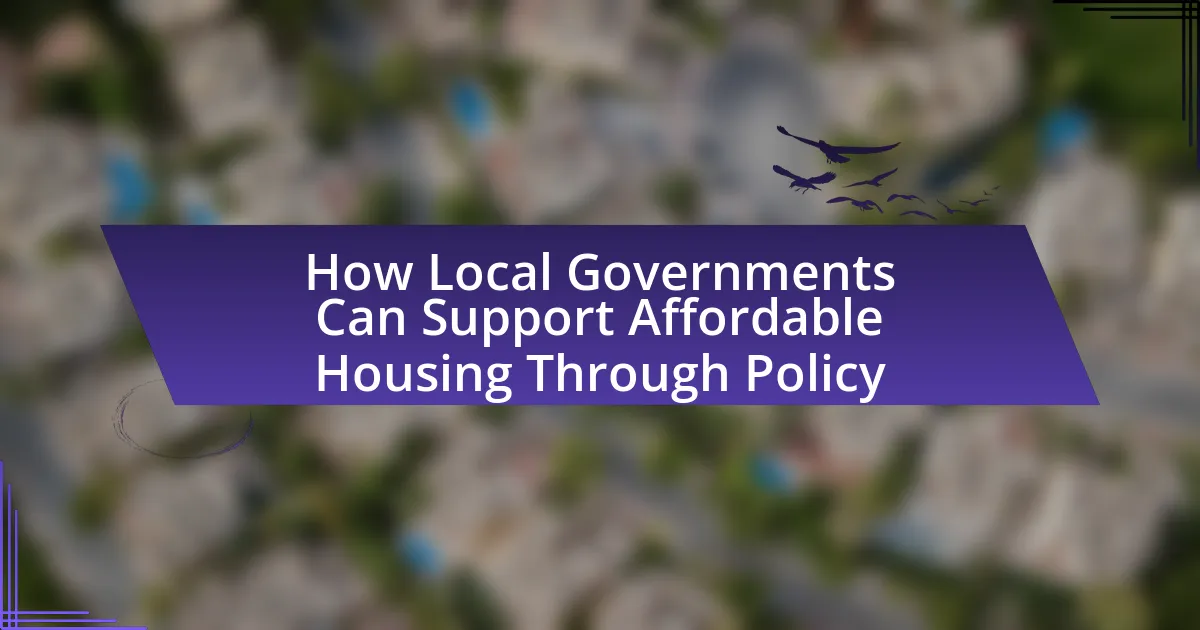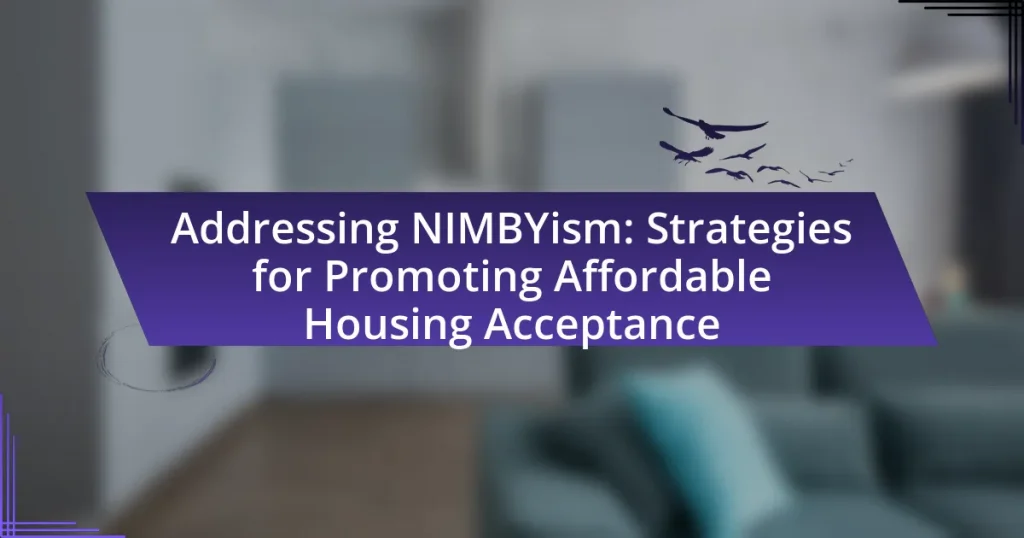Local governments play a pivotal role in shaping affordable housing policies through various mechanisms such as zoning regulations, financial incentives, and public-private partnerships. This article examines how local authorities can influence housing availability by adjusting zoning laws, implementing inclusionary zoning, and providing tax credits to developers. It also highlights the importance of community engagement and collaboration with organizations to address housing shortages and promote equitable access. Additionally, the article discusses the challenges faced by local governments in implementing these policies and presents successful case studies that demonstrate effective strategies for enhancing affordable housing initiatives.

How can local governments influence affordable housing policies?
Local governments can influence affordable housing policies by implementing zoning regulations, providing financial incentives, and facilitating public-private partnerships. Zoning regulations can be adjusted to allow for higher density housing, mixed-use developments, and the inclusion of affordable units in new projects, which directly impacts housing availability. Financial incentives, such as tax credits or grants for developers who build affordable housing, encourage the construction of such units. Additionally, local governments can foster public-private partnerships that leverage private investment in affordable housing projects, thereby increasing the overall supply. For example, cities like San Francisco have utilized inclusionary zoning policies to require developers to include affordable units in their projects, demonstrating a successful approach to influencing housing policy.
What are the key roles of local governments in housing policy?
Local governments play a crucial role in housing policy by regulating land use, zoning, and building codes to facilitate affordable housing development. They establish zoning laws that determine where different types of housing can be built, which directly impacts the availability of affordable units. Additionally, local governments often provide funding and incentives for affordable housing projects, such as tax credits or grants, to encourage developers to create low-income housing options. Furthermore, they engage in community planning and outreach to ensure that housing policies reflect the needs of residents, thereby promoting equitable access to housing. These roles are essential for addressing housing shortages and ensuring that diverse populations have access to affordable living options.
How do local governments define affordable housing?
Local governments define affordable housing as housing that costs no more than 30% of a household’s gross income for those earning at or below the area median income (AMI). This definition is widely adopted based on guidelines from the U.S. Department of Housing and Urban Development (HUD), which establishes that housing affordability is crucial for economic stability and community development. By adhering to this standard, local governments aim to ensure that low- and moderate-income families can access safe and decent housing without financial strain.
What legislative powers do local governments have regarding housing?
Local governments possess legislative powers that enable them to regulate housing through zoning laws, building codes, and land use policies. These powers allow local authorities to determine land use designations, set density requirements, and establish regulations for housing development, which can directly influence the availability and affordability of housing. For instance, local governments can implement inclusionary zoning policies that require developers to include affordable housing units in new projects, thereby promoting access to housing for low-income residents. Additionally, local governments can provide incentives such as tax abatements or grants to encourage the development of affordable housing, further demonstrating their legislative authority in shaping housing policy.
Why is affordable housing a critical issue for local governments?
Affordable housing is a critical issue for local governments because it directly impacts community stability, economic growth, and social equity. Local governments face increasing pressure to provide affordable housing options as rising housing costs lead to displacement and homelessness, which can strain public resources and services. According to the National Low Income Housing Coalition, there is a shortage of 7 million affordable rental homes for extremely low-income renters, highlighting the urgent need for policy interventions. Furthermore, affordable housing contributes to a diverse workforce, which is essential for local economies to thrive, as it allows individuals to live near their jobs and reduces commuting costs.
What are the social implications of affordable housing shortages?
Affordable housing shortages lead to increased homelessness, social instability, and economic disparity. When housing is unaffordable, low-income families often face eviction or are forced to live in substandard conditions, which exacerbates health issues and limits access to education and employment opportunities. According to the National Low Income Housing Coalition, in 2021, there was a shortage of 7 million affordable rental homes for extremely low-income renters, highlighting the scale of the crisis. This shortage not only affects individual families but also strains community resources, increases crime rates, and diminishes overall quality of life in affected areas.
How does affordable housing impact local economies?
Affordable housing positively impacts local economies by increasing disposable income for residents, which in turn stimulates local businesses. When families spend less on housing, they have more financial resources available for goods and services, leading to higher demand in the community. For instance, a study by the National Low Income Housing Coalition found that for every $1 invested in affordable housing, local economies can see a return of $1.50 to $2.00 in economic activity. Additionally, affordable housing can attract a diverse workforce, which enhances productivity and innovation within local industries. This economic boost contributes to job creation and overall community development, reinforcing the importance of affordable housing in fostering vibrant local economies.
What strategies can local governments implement to support affordable housing?
Local governments can implement strategies such as inclusionary zoning, which requires a percentage of new developments to be affordable, and the establishment of housing trust funds to finance affordable housing projects. Inclusionary zoning has been adopted in cities like San Francisco, resulting in the creation of thousands of affordable units. Housing trust funds, which have been utilized in states like Massachusetts, provide dedicated funding for affordable housing initiatives, demonstrating their effectiveness in increasing housing availability. Additionally, local governments can streamline permitting processes to reduce costs and encourage the development of affordable housing. These strategies collectively enhance the supply of affordable housing and address community needs.
How can zoning laws be adjusted to promote affordable housing?
Zoning laws can be adjusted to promote affordable housing by increasing density allowances, permitting mixed-use developments, and reducing minimum lot sizes. Increasing density allows for more housing units in a given area, which can lower costs through economies of scale. For example, cities like Minneapolis have eliminated single-family zoning, enabling the construction of duplexes and triplexes, which has led to a more diverse housing stock. Permitting mixed-use developments encourages the integration of residential and commercial spaces, fostering vibrant communities and reducing transportation costs for residents. Additionally, reducing minimum lot sizes can facilitate the development of smaller, more affordable homes, as seen in various urban areas that have adopted such measures. These adjustments can collectively enhance the availability of affordable housing options.
What financial incentives can local governments offer to developers?
Local governments can offer various financial incentives to developers, including tax abatements, grants, low-interest loans, and density bonuses. Tax abatements reduce or eliminate property taxes for a specified period, encouraging developers to invest in affordable housing projects. Grants provide direct funding to support construction or rehabilitation costs, while low-interest loans make financing more accessible and affordable. Density bonuses allow developers to build more units than typically permitted, increasing potential revenue. These incentives are designed to stimulate investment in affordable housing, addressing community needs and promoting economic growth.
How can local governments collaborate with community organizations for housing solutions?
Local governments can collaborate with community organizations for housing solutions by establishing partnerships that leverage resources, expertise, and community insights. These collaborations can take the form of joint initiatives, such as co-developing affordable housing projects, where local governments provide funding or land, while community organizations contribute local knowledge and outreach capabilities. For instance, the National Low Income Housing Coalition reports that such partnerships can enhance the effectiveness of housing programs by ensuring they meet the specific needs of the community. Additionally, local governments can engage community organizations in the planning process, allowing for more inclusive decision-making that reflects the voices of residents. This approach not only fosters trust but also increases the likelihood of successful housing solutions that are sustainable and widely accepted.
What are the challenges local governments face in implementing affordable housing policies?
Local governments face significant challenges in implementing affordable housing policies, primarily due to funding constraints, regulatory hurdles, and community opposition. Funding limitations often arise from budgetary restrictions and competing priorities, making it difficult to allocate sufficient resources for affordable housing initiatives. Regulatory hurdles include complex zoning laws and building codes that can delay or obstruct the development of affordable housing projects. Additionally, community opposition, often referred to as NIMBYism (Not In My Backyard), can hinder local governments’ efforts to introduce new affordable housing developments, as residents may resist changes that they perceive could negatively impact their neighborhoods. These challenges collectively impede the effective implementation of affordable housing policies.

What specific policies can enhance affordable housing initiatives?
Zoning reforms can enhance affordable housing initiatives by allowing for increased density and mixed-use developments. These reforms enable local governments to modify land-use regulations, which can lead to the construction of more affordable units. For instance, cities like Minneapolis have successfully implemented zoning changes that eliminate single-family zoning, resulting in a significant increase in housing supply. Additionally, inclusionary zoning policies require developers to allocate a percentage of new units for affordable housing, thereby directly contributing to the availability of affordable options. Studies show that such policies can lead to a more equitable distribution of housing resources, improving access for low-income families.
How do inclusionary zoning policies work?
Inclusionary zoning policies require developers to include a percentage of affordable housing units in new residential projects. These policies aim to increase the availability of affordable housing by mandating that a portion of the units be set aside for low- to moderate-income households, often in exchange for benefits such as density bonuses or expedited permitting. For example, in San Francisco, the inclusionary zoning policy mandates that 12-25% of units in new developments be affordable, depending on the project’s size and location. This approach helps integrate affordable housing into diverse neighborhoods, promoting social equity and reducing economic segregation.
What are the benefits of inclusionary zoning for communities?
Inclusionary zoning benefits communities by promoting affordable housing options and fostering socioeconomic diversity. This policy requires developers to include a percentage of affordable units in new residential projects, which helps to increase the overall supply of affordable housing. For instance, a study by the Urban Institute found that inclusionary zoning can lead to the creation of thousands of affordable units in urban areas, thereby reducing housing cost burdens for low- and moderate-income families. Additionally, inclusionary zoning can enhance community stability by preventing displacement and encouraging mixed-income neighborhoods, which contribute to social cohesion and economic vitality.
What challenges do local governments face with inclusionary zoning?
Local governments face several challenges with inclusionary zoning, primarily related to balancing housing affordability with market dynamics. One significant challenge is the potential pushback from developers who argue that inclusionary zoning requirements can reduce profitability, leading to fewer new housing projects. Additionally, local governments may struggle with the administrative complexity of implementing and monitoring inclusionary zoning policies, which can strain limited resources. Furthermore, there is often a lack of consensus among stakeholders, including community members and housing advocates, about the best approach to inclusionary zoning, complicating policy formulation. These challenges can hinder the effectiveness of inclusionary zoning as a tool for promoting affordable housing.
What role do tax credits play in affordable housing development?
Tax credits are essential in affordable housing development as they provide financial incentives that reduce the cost of construction and operation for developers. By lowering the tax burden, these credits enable developers to allocate more resources towards creating and maintaining affordable housing units. For instance, the Low-Income Housing Tax Credit (LIHTC) program has facilitated the creation of over 3 million affordable housing units since its inception in 1986, demonstrating its significant impact on increasing housing availability for low-income families.
How can local governments effectively utilize tax credits?
Local governments can effectively utilize tax credits by implementing targeted programs that incentivize affordable housing development. By offering tax credits to developers who build or rehabilitate affordable housing units, local governments can stimulate investment in underserved areas. For instance, the Low-Income Housing Tax Credit (LIHTC) program has successfully increased the availability of affordable housing, resulting in the creation of over 3 million affordable homes since its inception in 1986. This program demonstrates how tax credits can attract private investment while addressing housing shortages, thus validating the effectiveness of such strategies in local housing policy.
What are the limitations of tax credits in supporting affordable housing?
Tax credits have several limitations in supporting affordable housing, primarily due to their reliance on private investment and market conditions. These credits often do not guarantee the creation of sufficient affordable units, as developers may prioritize higher-profit projects. Additionally, tax credits can be subject to fluctuations in funding availability, which can lead to inconsistent support for affordable housing initiatives. For instance, the Low-Income Housing Tax Credit program has faced funding cuts in various states, limiting its effectiveness. Furthermore, the complexity of the application process can deter smaller developers from participating, thereby reducing the overall impact on affordable housing supply.
How can local governments ensure long-term affordability in housing?
Local governments can ensure long-term affordability in housing by implementing inclusionary zoning policies that require a percentage of new developments to be affordable for low- and moderate-income households. This approach has been successfully adopted in cities like San Francisco, where such policies have contributed to the creation of thousands of affordable units. Additionally, local governments can establish community land trusts, which remove land from the speculative market and maintain affordability over time, as demonstrated by the Burlington Community Land Trust in Vermont, which has preserved affordable housing for decades. By combining these strategies with funding mechanisms such as housing trust funds, local governments can create a sustainable framework for long-term housing affordability.
What mechanisms can be put in place to maintain affordability over time?
To maintain affordability over time, local governments can implement mechanisms such as inclusionary zoning, which requires developers to allocate a percentage of new housing units for low- and moderate-income residents. This approach has been successfully adopted in cities like San Francisco, where policies have resulted in the creation of thousands of affordable units. Additionally, establishing long-term affordability covenants can ensure that properties remain affordable for a specified duration, as seen in programs across various states that tie affordability to the duration of public funding. Furthermore, local governments can provide property tax incentives for affordable housing developments, which has been shown to encourage investment while keeping rents lower. These mechanisms collectively contribute to sustained affordability in housing markets.
How can local governments monitor and evaluate the effectiveness of their policies?
Local governments can monitor and evaluate the effectiveness of their policies by implementing data collection methods, stakeholder feedback mechanisms, and performance metrics. Data collection methods, such as surveys and housing market analysis, provide quantitative insights into policy impacts, while stakeholder feedback, including community forums and consultations, offers qualitative perspectives on policy effectiveness. Performance metrics, such as the number of affordable housing units created or the reduction in homelessness rates, serve as concrete indicators of success. For instance, a study by the Urban Institute found that cities employing comprehensive data tracking and community engagement saw a 20% increase in affordable housing development compared to those that did not. This evidence underscores the importance of a multifaceted approach in assessing policy effectiveness.

What best practices can local governments adopt for successful affordable housing policies?
Local governments can adopt several best practices for successful affordable housing policies, including implementing inclusionary zoning, increasing funding for affordable housing development, and fostering public-private partnerships. Inclusionary zoning mandates that a percentage of new developments be affordable, which has been shown to increase the availability of affordable units in cities like San Francisco, where such policies have led to the creation of thousands of affordable homes. Increasing funding through local budgets or leveraging federal and state resources can provide the necessary financial support for affordable housing projects, as evidenced by the success of programs in cities like New York, which allocated significant funds to affordable housing initiatives. Additionally, fostering public-private partnerships can enhance resource sharing and innovation, as seen in successful collaborations in places like Seattle, where partnerships have led to the development of mixed-income housing projects that benefit the community.
How can community engagement improve housing policy outcomes?
Community engagement can improve housing policy outcomes by ensuring that policies reflect the actual needs and preferences of residents. When local governments actively involve community members in the decision-making process, they gain valuable insights into the specific housing challenges faced by different demographics. For instance, a study by the Urban Institute found that inclusive engagement leads to more effective policies, as they are tailored to address the unique concerns of the community, such as affordability, accessibility, and sustainability. This participatory approach not only fosters trust between residents and policymakers but also enhances the likelihood of successful implementation and acceptance of housing initiatives.
What methods can local governments use to involve residents in housing discussions?
Local governments can involve residents in housing discussions through methods such as public forums, surveys, and participatory budgeting. Public forums allow residents to voice their opinions and concerns directly to decision-makers, fostering community engagement. Surveys can gather quantitative data on resident preferences and needs, ensuring that diverse perspectives are considered in housing policies. Participatory budgeting enables residents to have a direct say in how funds are allocated for housing projects, promoting transparency and accountability. These methods have been shown to enhance civic participation and improve the relevance of housing policies to community needs.
How can feedback from the community shape housing policies?
Feedback from the community can significantly shape housing policies by providing local governments with insights into residents’ needs and preferences. When community members express their opinions on housing issues, such as affordability, accessibility, and design, policymakers can tailor regulations and initiatives to better align with these expressed needs. For instance, studies have shown that community engagement in planning processes leads to more effective and accepted housing solutions, as seen in the 2018 report by the Urban Institute, which highlighted that inclusive feedback mechanisms resulted in policies that better addressed local housing shortages. This direct input helps ensure that housing policies are not only effective but also equitable, reflecting the diverse voices within the community.
What lessons can be learned from successful affordable housing initiatives in other regions?
Successful affordable housing initiatives in other regions demonstrate the importance of collaboration between government, non-profits, and private sectors. For instance, the inclusionary zoning policies in San Francisco have led to the creation of thousands of affordable units by requiring developers to allocate a percentage of new housing for low-income residents. Additionally, the use of public land for affordable housing projects in Vienna has resulted in a sustainable model that prioritizes long-term affordability and community integration. These examples highlight that effective policies often involve mixed-income developments, streamlined permitting processes, and financial incentives for developers, which collectively contribute to the success of affordable housing initiatives.
What case studies exemplify effective local government strategies for affordable housing?
Case studies that exemplify effective local government strategies for affordable housing include the inclusionary zoning policy in San Francisco and the Housing First initiative in Salt Lake City. San Francisco’s inclusionary zoning requires developers to set aside a percentage of new housing units for low-income residents, resulting in thousands of affordable units since its implementation in 2002. Salt Lake City’s Housing First initiative, launched in 2005, focuses on providing permanent housing to the homeless, which has led to a 91% reduction in chronic homelessness. These examples demonstrate how targeted policies can effectively address affordable housing challenges in urban areas.
How can local governments adapt successful strategies to their unique contexts?
Local governments can adapt successful strategies to their unique contexts by conducting thorough assessments of local needs and resources, then tailoring proven policies to fit those specific circumstances. For instance, a local government might analyze demographic data, housing market trends, and community feedback to identify gaps in affordable housing. By leveraging successful models from other regions, such as inclusionary zoning or community land trusts, they can modify these strategies to align with local economic conditions and cultural factors. Evidence from the National Low Income Housing Coalition indicates that cities implementing customized affordable housing policies have seen a significant increase in housing availability, demonstrating the effectiveness of context-specific adaptations.
What practical steps can local governments take to enhance affordable housing today?
Local governments can enhance affordable housing today by implementing inclusionary zoning policies that require developers to allocate a percentage of new housing units for low-income residents. This approach has been successfully adopted in cities like San Francisco, where inclusionary zoning has resulted in thousands of affordable units being created. Additionally, local governments can streamline the permitting process for affordable housing projects, reducing delays and costs associated with development. For instance, Minneapolis has adopted measures to expedite approvals, which has encouraged more affordable housing construction. Furthermore, local governments can establish or expand housing trust funds to provide financial resources specifically for affordable housing initiatives, as seen in Seattle, where such funds have supported various affordable housing projects. These practical steps demonstrate a commitment to increasing the availability of affordable housing options in local communities.



